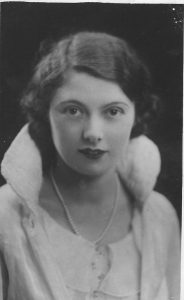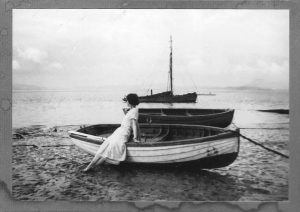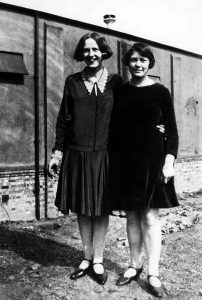1928 – A Swallow Summer by Constance Teather (nee Dickson)

Connie Teather
(© Harry Teather)
This article, originally published in The Automobile in April 1985, was written by Connie Teather (nee Dickson) who had joined the Swallow Sidecar and Coachbuilding Co in Blackpool aged 17 in 1928. Her parents were originally against her moving down to Coventry and she only made the move after receiving a telegram from William Lyons, at the instigation of Alice Fenton, urging her to join them. She shared digs, and later a house, with Alice and in 1936 married Harry Teather who had also moved down from Blackpool. Harry was one of the company’s first employees having joined in 1923 and worked for the company for a full fifty years, retiring as Jaguar’s Director of Purchasing.
The article gives an interesting insight into what it was like working for the company in Blackpool in 1928 – when the company had only been in existence for 6 years and work and life all seemed much simpler.
1928 – A Swallow Summer by Constance Teather
I started work at the Swallow Coachbuilding Co. in April 1928, the month of my 17th birthday. I had had a job in Blackpool the previous winter in the office of a small shop filled with car tyres, but the man who owned it didn’t sell enough and closed down.
My home was at Fleetwood, a small fishing town about ten miles away, but I would come to Blackpool on Monday mornings to go to the library to look at the ‘Situations Vacant’ in the weekly edition of the Blackpool Gazette and Herald. It was issued on a Friday, and why I didn’t go to see the paper on Friday, I can’t remember – perhaps because there was usually a queue in the library. If you couldn’t afford a paper that is where you went to read, and my family was poor. I was the eldest of five children.
My father was an electrician for the London Midland & Scottish Railway, and I travelled quarter fare by train which was 2½d (1p). I also used to enjoy reading the Manchester Guardian (now The Guardian) in the library. However, that morning I saw the advertisement: “Office Junior required by the Swallow Sidecar and Coachbuilding Company”, and I set out to find the place in Cocker Street as quickly as possible.
Immediately inside the factory door on the left was the office. There was timber to desk height, then glass panelling so the staff could see who came in; and there was an “Enquiry” window. It was there that I first saw Alice Fenton, who asked me to wait. She had very striking colouring – a pink complexion with rosy cheeks and hazel eyes and (I thought) the most beautiful hair I had ever seen; parted in the centre, it waved down her cheeks into a long plait which ended in a curl stretching nearly to her waist. My hair was brown and very short, and I thought she looked very efficient and business-like in a dark dress with a small white collar.
The ground floor of the factory had a large enclosed paint-shop opposite the office. It was painted white, and I was told later that it has a special floor to make it dust-free for the painting of the Swallow car bodies. The sidecars were painted in a different part of the building upstairs. There was a big door at the back of the paint-shop where the chassis were received. There was also a very large lift, I think the largest in the north of England.
Later I was asked to come into the office for interview by Mr Lyons, who dictated a letter which I had to type; he also tested me on percentages and decimals which I found very easy. At that time the school-leaving age was fourteen. Those who stayed on at school further were taught shorthand and English as an extra subject; but I had to pick up typing myself, as my parents could not afford to pay for tuition. Anyone over fourteen was also able to attend evening classes so, by the time I was seventeen I had been going to night-school for three years. I took a commercial course on Monday, Tuesday and Thursday and French on Wednesday. In April 1928 we were taking exams for the intermediate diploma of the R.S.A.
I was very nervous at that first interview with Mr Lyons – in fact, I was always nervous of him and felt unable to do my best on the few occasions he asked me to do anything for him. I was very grateful when he asked me when I could start and offer me a wage of 10/- (50p) per week. [Lyons had initially offered her 5/- (25p) per week and after commenting that it would cost her half that in fares – it was increased to 10/-.] Afterwards Alice Fenton told me that the previous Saturday morning there had been a long queue of applicants for the job and she was surprised when, after I had left, he told the staff that he had asked me to start and that at least I didn’t smell of scent. I can only think that as usual he was very busy when I presented myself, and when I passed the test it was an easy way to finish the matter so he could turn his attention to more important business.
I found I was not to be in the main office with the others – Miss Atkinson who was a mature 35-year-old (and My Lyons’ secretary), the Company Secretary Mr Lee and Alice Fenton as general office girl. The small inner office where I had been interviewed was shared by Mr Lyons and Mr Walmsley. I was upstairs in the stores office, where Mr Whittaker was in charge. He had originally worked as a salesman, touring the motor-cycle agents with a Swallow Side-car, but when I started work he had been brought into the office to attend to the buying side of the business which was increasing with the advent of car body production. We also dealt with service and spares for an ever increasing volume of sidecar business. Purchase orders, invoices and advice notes all came into our sphere and this is where I found my experience of night school so very useful. For some reason, I remember spare ball joints always being in demand. Harry Teather was one of the earliest employees: he’d joined in the spring of 1923, at the old Bloomfield Road premises. He’d just moved from the paint-shop because he couldn’t stand the peardrop smell, and was now in charge of the stores where I remember him making up special prescription “Swallow” aluminium polish for side-car bodies, using a 5-gallon drum. The polish was sold at 1/9d (8p) a tin. I issued him with instructions for any spares ordered and, when he had packed them, it was my duty to take them to the post office.
Mr Lyons and Mr Walmsley had got beyond the motor-cycle stage, and each used an Alvis. I remember them usually wearing plus-fours. Mr Walmsley’s Alvis had a body built by Mr Holland, who had come up from the Midlands to get the Austin Swallow designed and into production.
Near the door of the main office downstairs there were wooden stairs which led to the first floor of the factory. Along one side of the large room near the window, the side-cars were built and trimmed. Car bodies covered the rest of the floor, first taking shape with strong timber frames and then covered in with aluminium panels before being trimmed and the seats fitted. In one corner near the window was Mr Holland with a drawing-board, and at the far end of this long room there was an anvil and a welding plant used to make the alterations required to the chassis received from the Austin Motor Company. One operation I can remember was lengthening the starting handles to go through the specially designed radiators.
The sidecar paint-shop was underneath the stores and in charge of that was ‘Sam’. (His real name was Cyril Marshall but Mr Walmsley who was in charge of the factory had said that was too fancy a name, so he was always known as Sam). He was a very good pianist; Harry Teather played the violin, and they used to transcribe music together, to save buying it. They were both interested in photography, too.

Connie Teather at Fleetwood
(© Harry Teather)
I became very friendly with Alice Fenton, and I remember that summer of 1928 as being very happy with the sun always shining (although it probably wasn’t). My train from Fleetwood arrive at ten-to-nine so I had to run through the streets to be in time for the office. I can recall vividly the buskers playing outside the small guest-houses where visitors would be sitting in the bay windows having breakfast, often with the window open if the morning was fine enough, and throwing pennies to the buskers. It was the summer of My Blue Heaven and Bye Bye Blackbird. Hearing them played merrily on saxophone and trumpet always got the day off to a good start for me.
Jack Beardsley was in charge of the anvil. He belonged to a choir and had a fine voice and I enjoyed listening to him singing at the anvil as he worked – and listening to the boys whistling popular tunes. It was a very free and easy ‘young atmosphere’, though everybody was always busy working.
I used to take sandwiches for lunch, but it was the custom then for everybody to go home for midday dinner. The works closed for an hour and the office staff had from 12.30 until 2.00 pm off. I think Alice thought I was a bit of a ‘character’ as when I had to go down to the main office on an errand, like collecting the post, I used to make quips and try to be very witty – the result of being 17 I suppose. This used to send them all into fits of laughter. Alice would invite me to walk some of the way home with her at lunchtime as the works at Cocker Street were in Blackpool North and she lived in Blackpool South – so we used to stride down the promenade to save bus fare, talking and laughing and rolling round at something we found very funny.
Alice really opened up a whole new world for me because in between laughing we would discuss music – I had learned to play the piano, but she was far more expert and had a far bigger repertoire. Before working at the Swallow she had worked for Mr Lyons’ parents in their large music shop in the centre of town. She had often played on one of the grand pianos to attract customers as, at that time, everyone seemed to buy sheet music whether it was “good” music or the popular kind. We also discussed the shows in Blackpool. There really was a wonderful selection then, though I had been discouraged from seeking the bright lights. “A place of iniquity”, my father called Blackpool. In 1928 there was the Desert Song at the Opera House and I remember Raymond Massey and Gertrude Lawrence at the Grand Theatre in Merchant of Venice, as well as all the big music hall stars.
Gradually Alice and I began to meet for Saturday evenings out. We want dancing together at the Winter Gardens in very short evening dresses two inches above the knee which was the fashion. I don’t think Alice had been used to going out on Saturdays either and had spent most of her leisure studying, but she was careful that we only danced together. We also discussed books and literature, in which she was more advanced, and she suggested better books that I might find in the library to read on the way home on the train. I got to know John O’London’s Weekly, and Agatha Christie became one of my favourite story tellers. Alice and I became very close and I was very impressed and flattered to have her friendship.
It was a nasty surprise to see a notice on the works time-clock that autumn to say the firm was moving to Coventry, and would any employees who wished to go sign their names. It gave a list of addresses where lodgings could be found. I just thought that it was the end of my job. Alice confided to me that Mr Lyons had asked her (not Miss Atkinson) to go to Coventry as his secretary, and that her parents had agreed. Poor Miss Atkinson was very upset. I had started night school again for the finals of the R.S.A. with all my pals. When I was late and missed the train, I travelled home by tram which ran along the coast, often enjoying the glorious sunsets over the sand and sea, thinking that my days of travelling to Blackpool were numbered, as was my life with Alice. I think it was at Alice’s instigation that one day, I timidly knocked on Mr Lyons’ office door and asked if I too could go to Coventry. “What!” he said, “Come to Coventry? How old are you – 17? Have you asked your parents? No! Well go and find another job”… – which I did, with the Boston Deep sea Fishing Company in Fleetwood.

1928 Alice Fenton and Connie Dickson at
Swallow Road,
Foleshill, Coventry
Alice said that Mr Lyons thought it might be a good idea for her to try putting up her hair to make her look a little older and more mature. Poor Alice tried all week to put up her hair in various styles, all of which she thought was ugly. In desperation, on the last Saturday before she was to leave on the Big Adventure, she decided she must have it all cut off and bobbed. So I went with her that Saturday afternoon when she had made an appointment at one of the best hairdressers, and she wept as she was shorn. We put the big curl at the end of the plait in a box and brought it home.
Mrs Fenton had invited me and about six of Alice’s other friends to a farewell evening. Most of them were from school days, and Alice’s younger sister was there, too. They all seemed a very talented lot to me; one girl gave a piano recital and Alice played Rustle of Spring with very clever fingering. Another girl had a car; it was unusual for a girl to have learned to drive so young and she drove me back to the station with Alice to catch the train, where I said a final goodbye.
I still treasure the poem which she wrote in my autograph book as a keepsake – from Ernest Raymond’s book “Tell England” – about the faith which life had taught the poets in the days of the Great War: to live each minute of each hour to the full. Alice was a very vital person and lived up to this motto all her life.
I did not know that evening, that within a fortnight I would receive a telegram asking if I was still interested in coming to Coventry.
_______________________________________________
Author: Connie Teather – originally published in The Automobile in April 1985
Additional Notes:
Connie did move to Coventry and shared digs and later a house with Alice Fenton.
She married Harry Teather in 1936 at which point she retired, and they had three children together.
Connie Teather attended Sir William’s Thanksgiving Service at Coventry Cathedral at 3 pm on 27th February 1985, conducted by the Bishop of Warwick.
Sources and Further Reading:
-
Whyte, Andrew, Jaguar: The Definitive History of a Great British Car (Patrick Stephens Limited, 1990)
-
Porter, Philip and Skilleter, Paul, Sir William Lyons: The Official Biography (Haynes Publishing, 2001)